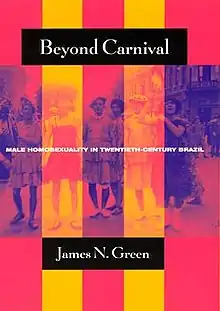Beyond Carnival
Beyond Carnival: Male Homosexuality in Twentieth-Century Brazil is a book by historian James N. Green published by the University of Chicago Press in 1999.[1] The book details the development of the homosexual subcultures that developed in Rio de Janeiro and São Paulo, specifically regarding gay men.
 | |
| Author | James N. Green |
|---|---|
| Country | United States |
| Language | English |
| Genre | Non-Fiction |
| Published | 1999 |
| Publisher | University of Chicago Press |
Publication date | 1999 |
| Pages | 407 |
| ISBN | 0-226-30638-0 |
Beyond Brazil is Green's first published book, and was followed by We Cannot Remain Silent: Opposition to the Brazilian Military Dictatorship in the United States.[2]
Synopsis
Beyond Carnival draws attention to the lives of the male homosexual population in Brazil, specifically Rio de Janeiro and São Paulo. Green claims that homosexuality, though somewhat accepted by the general population, is still overall disapproved of. Combined with the current discrimination faced by the LGBT community in Brazil, Green's belief is that focusing exclusively on male homosexuals not only provides insight on a marginalized group, but also into how Brazilian's understand concepts of masculinity and femininity, acceptable behavior, and shared societal values. Medical studies, depositions of arrested men, autobiographies, and personal interviews are among the primary sources used in Green's analysis of the subculture among gay men that developed in Brazil's urban centers.
Green details the history of the gay male community, beginning in the late 18th century. Given the lack of studies on the community, the vast majority of information is compiled from police reports. Though homosexuality was not explicitly illegal, Brazilian police were able to arrest gays found engaging in sexual activities for violating laws of public indecency, vagrancy, or sodomy. Most reports of these interactions came from the Largo do Rossio park in Rio de Janeiro. The novel Bom-Crioulo by Adolfo Caminha was published during this time, portraying homosexual encounters in a positive light. Contemporaries of Caminha harshly criticized the novel for covering such an immoral practice, reflecting attitudes of this era. Studies of gay men focused entirely on a bicha/bofe paradigm, in which the penetrated was a feminine bicha, and the "real man" was the bofe, or penetrator. Leonídio Ribero's Homosexualismo e endocrinologia was the most commonly cited study explaining biological differences between "sick" gay men and "healthy" heterosexual men. These early studies on gay relationships emphasized a smaller community of gay men, with no acknowledgement of diversity within the subgroup, such as Madame Satã, who acted "masculine" but enjoyed to be the bicha in relationships.
After World War II, as a mass influx of immigrants arrived in Brazil. With increased interaction with the United States and newer cultures, the label of entendido emerged in middle class gay populations to define someone who failed to fit into the strict active or passive roles in sex. Unlike past medical studies, José Fábio Barbosa da Silva focused on the wider population of gay men, claiming that past studies may have been biased due to the understanding of homosexuality as an illness rather than a natural occurrence. Rio de Janeiro and São Paulo were the first to begin releasing gay themed magazines, like O Snob, which exclusively focused on gay culture and gossip. The increased representation of gay men in Brazilian society allowed gay culture to become more common among the general population.
The popularization of carnival in Brazil allowed drag performers to enter the public eye under the guise of costumes and celebration. Gay clubs with drag performances grew more common in the two major cities, along with a rise in cross-dressing prostitution within the cities. 1970's Brazil saw an emergence of a visible gay rights movement, with activists pushing for greater representation in media and laws protecting the LGBT community from discrimination. National conversations concerning civil marriage and social violence and increased representation in carnival, Green claims, have established a growing movement for national recognition that homosexual identities are just as valid as their heterosexual counterparts.[1]
Critical reception
- Review by Charles Klein in the Canadian Journal of Latin American and Caribbean Studies 107 (2002): 261–262.
- "Green does an outstanding job of taking apart popular stereotypes (e.g., Brazil is the land of liberated sexuality) and theoretical constructs (e.g., "traditional" versus "modern" sexualities) in his discussion of Brazilian gender/sexual worlds."[3]
- Review by Susan Besse in the Journal of Social History 35 (2001): 470-471.
- "In looking at Brazil through a new lens, Green expands our understanding of the variety of ways in which Brazilian culture often tolerates (or even embraces) social differences while still preserving the rigid hierarchies and social exclusions that perpetuate privilege."[4]
Awards
Beyond Carnival won the Pacific Coast Council on Latin American Studies' Hubert Herring Award for Best Book and the Lambda Literary Foundation/Paul Monette-Roger Horwitz Trust Award.[5]
References
- Beyond Carnival.
- "James N. Green | Watson Brazil Initiative". watson.brown.edu. Retrieved 2018-02-27.
- Klein, Charles (2003). "Review of "Beyond Carnival: Male Homosexuality in Twentieth-Century Brazil by James N. Green"". Canadian Journal of Latin American and Caribbean Studies. 28: 315–317.
- Besse, Susan (2001). "Review of 'Beyond Carnival: Male Homosexuality in Twentieth-Century Brazil,' by James N. Green". Journal of Social History. 35: 470–471.
- "James Green (Brazil) - SourceWatch". www.sourcewatch.org. Retrieved 2018-01-22.